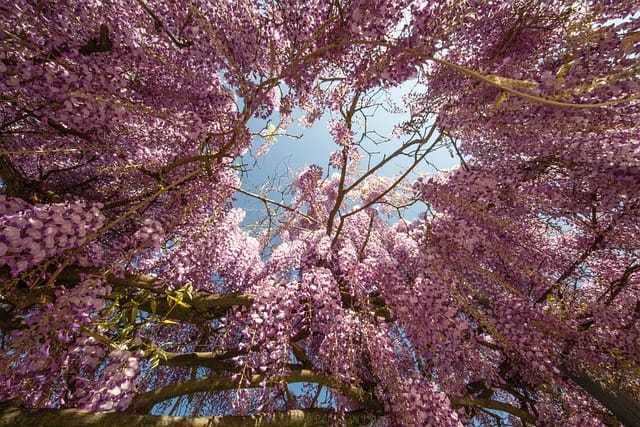How to grow Wisteria (Wisteria)
The Wisteria (Wisteria) climber is a breathtakingly beautiful plant known for its stunning clusters of fragrant flowers

In this article:
- Introduction
- Choosing the Right Variety of Wisteria
- Selecting the Planting Location
- Planting the Wisteria
- Providing the Ideal Growing Conditions
- Watering and Fertilizing the Wisteria
- Pruning and Training Techniques for a Healthy Climber
- Dealing with Common Pests and Diseases
- Propagation Methods for Wisteria
- Harvesting Wisteria Flowers
- Tips for Maintaining a Beautiful Wisteria Display
- Conclusion
Introduction
The Wisteria (Wisteria) climber is a breathtakingly beautiful plant known for its stunning clusters of fragrant flowers. It can add a touch of elegance and charm to any garden or outdoor space. In this article, we will guide you through the process of growing and caring for the Wisteria climber, ensuring that it thrives and becomes a focal point of your landscape.
Choosing the Right Variety of Wisteria
Before getting started, it's important to choose the right variety of Wisteria for your climate and garden. There are several popular varieties, including Wisteria sinensis and Wisteria floribunda. Research the characteristics of each variety and select one that will thrive in your specific location.
Selecting the Planting Location
Wisteria thrives in full sun, so choose a location that receives at least six hours of direct sunlight per day. It also prefers well-draining soil with a pH between 6.0 and 7.0. Consider the space available, as Wisteria can grow large and may require sturdy support structures such as trellises or pergolas.
Planting the Wisteria
Prepare the planting hole by loosening the soil and incorporating organic matter such as compost. Dig a hole that is twice as wide and deep as the root ball of the plant. Gently place the Wisteria in the hole, ensuring that the bud union (swollen area where the plant was grafted) is level with the soil surface. Backfill the hole with soil, firming it gently around the plant.
Providing the Ideal Growing Conditions
Once planted, ensure that the Wisteria receives adequate sunlight, water, and nutrients. Mulch around the base of the plant to retain moisture and suppress weed growth. Regularly check the soil moisture level and irrigate accordingly, keeping it consistently moist but not waterlogged. Wisteria also benefits from a balanced fertilizer applied in early spring and after the first bloom.
Watering and Fertilizing the Wisteria
Water the Wisteria deeply and infrequently, allowing the soil to dry out between waterings. This encourages the plant to develop deep roots and become more drought-tolerant. However, avoid letting the soil completely dry out, especially during the growing season. When it comes to fertilization, use a balanced slow-release fertilizer formulated for flowering plants, following the package instructions for application rates.
Pruning and Training Techniques for a Healthy Climber
Proper pruning and training are crucial for maintaining a healthy and beautiful Wisteria climber. Prune in late winter or early spring, removing any dead, damaged, or diseased branches. Also, prune to shape the plant to your desired form. Train the Wisteria by guiding the long shoots along support structures and trimming back excessive growth. This helps promote proper airflow and prevents the plant from becoming too dense.
Dealing with Common Pests and Diseases
While generally tough plants, Wisteria can be susceptible to certain pests and diseases. Common problems include aphids, scale insects, powdery mildew, and root rot. Regularly inspect your plant for signs of infestation or disease and take appropriate measures such as using insecticidal soap or fungicides. It's also important to maintain good plant hygiene by keeping the area around the Wisteria clean and free of debris.
Propagation Methods for Wisteria
If you wish to propagate your Wisteria, there are several methods you can try. These include hardwood cuttings, softwood cuttings, and layering. Hardwood cuttings are taken in late winter, while softwood cuttings can be taken in early summer. Layering involves bending a long, flexible shoot into the ground and burying it until roots form. Each method has its own requirements and success rates, so choose the one that suits your situation best.
Harvesting Wisteria Flowers
Wisteria flowers are not only stunning to look at, but they also have a lovely fragrance. Harvesting the flowers can be a rewarding experience. To do so, wait until the flowers are fully open and gently cut the desired cluster, making sure to leave enough foliage behind for the plant to continue growing. Enjoy the flowers indoors or use them to create beautiful floral arrangements.
Tips for Maintaining a Beautiful Wisteria Display
To maintain a beautiful Wisteria display, consider the following tips:
- Regularly check for damaged or diseased branches and promptly remove them.
- Monitor growth and train the plant to ensure it does not become overly invasive or tangled.
- Apply a layer of mulch annually to help retain moisture and suppress weeds.
- Provide support structures such as trellises or pergolas for the Wisteria to climb.
- Consider annual pruning to control growth and encourage abundant blooms.
Conclusion
Growing and caring for the Wisteria climber can be a rewarding experience. By choosing the right variety, providing ideal growing conditions, and implementing proper pruning and training techniques, you can ensure a healthy and beautiful display. Remember to stay vigilant for pests and diseases, practice good plant hygiene, and take a moment to enjoy the breathtaking beauty and fragrance of the Wisteria flowers. Happy gardening!
